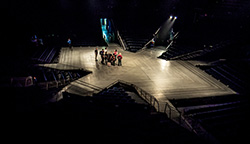News From Mark Shanda, USITT President
Really Behind The Scenes
 We like to hide what we do. In fact, we invest in elaborate systems of curtains and track, or skillfully placed architectural features to prevent the audience from seeing the lighting equipment in use, the motion control mechanics, the quick change booth, as well as hiding the crew that is working hard to assist in bringing the show to life in performance. Yet, there are times that all of our efforts to prevent folks from knowing what we are doing can backfire.
We like to hide what we do. In fact, we invest in elaborate systems of curtains and track, or skillfully placed architectural features to prevent the audience from seeing the lighting equipment in use, the motion control mechanics, the quick change booth, as well as hiding the crew that is working hard to assist in bringing the show to life in performance. Yet, there are times that all of our efforts to prevent folks from knowing what we are doing can backfire.
Our secret keeping can, at times, undermine our quest for appropriate levels of financial support to enable us to realize the best possible production. Theatres everywhere seem to struggle financially. Many approach production with just enough resources to "get by" and we designers and technicians often rise to the occasion by investing longer hours and through some amazing ingenuity actually pull off more than what seemed possible.
While I am a big fan of creativity, I am not very tolerant of working excessively long hours. To overcome our tendency to hide out, I would encourage all producers to occasionally draw back the curtains and let others in on both the challenges and the rewards of backstage work. The next time you integrate automation into a production, plan an open house demonstration for either target audiences like the physics faculty from your campus, or just a post show talk back that demonstrates the "how" of the special effects that you were able to integrate into your production.
Consider a pre-show audience conversation to give those who have made the effort to come to your production some insight into the research, design, and fabrication processes that have brought your project to life. In a production that has a quick change in the first act, seize a moment during intermission to demo the dressers at work. Take advantage of lobby wall space to feature displays that tell the story, not just of the production, but of the production process. Our collaborative artistry deserves to be on display beyond the results of the live performance and in multiple creative ways.
As more of our audiences understand the critical roles of the variety of production personnel necessary to bring a show or project to life, the more likely we will find allies when we need to justify our resource requests. Using the power of knowledge could lead to greater advocacy for appropriate funding and support. While we want to continue to celebrate our ability to surprise and astonish, from time to time, let's spread the word about our many talents as designers and technicians to increase understanding.
Sharing your work with others in the industry is also a great way to help all further develop their skills. Events like Cover the Walls, the Design Expo, and the Tech Expo are all opportunities to spread the word about the work that you do. All of us have an obligation to advocate for the creative artistry that is live performance!


We'd like to hear your comments on this story.
Please e-mail Mark at Shanda.1@osu.edu.